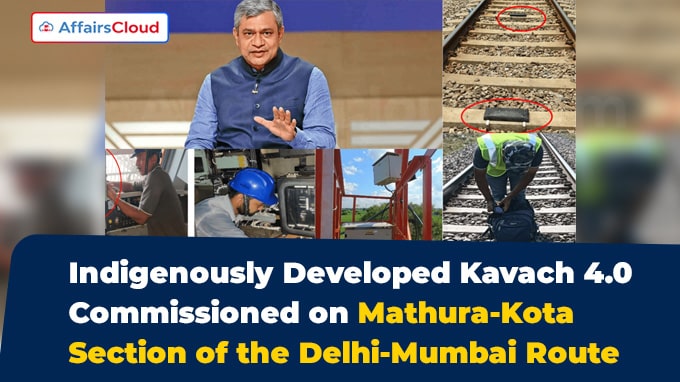 On 30th July 2025, Indian Railways (IR), under the Ministry of Railways (MoR), commissioned the indigenously developed Automatic Train Protection (ATP) system Kavach 4.0 on the Mathura–Kota section of the high-density Delhi–Mumbai rail corridor, marking a significant advancement in the modernization of railway safety infrastructure.
On 30th July 2025, Indian Railways (IR), under the Ministry of Railways (MoR), commissioned the indigenously developed Automatic Train Protection (ATP) system Kavach 4.0 on the Mathura–Kota section of the high-density Delhi–Mumbai rail corridor, marking a significant advancement in the modernization of railway safety infrastructure.
Exam Hints:
- What? ATP system ‘Kavach 4.0’ deployed
- Where? Mathura–Kota section, Delhi–Mumbai rail corridor
- Implementer? Indian Railways, MoR
- Approval: RDSO, MoR
- Purpose: To enhance train safety, prevent collisions, and improve speed control
- MoU Signed By? IRISET & 17 AICTE-approved institutions
- Components of Kavach: RFID Tags, Telecom Towers, Loco Kavach, Station Kavach, OFC, Signalling System
About Kavach:
Development Timeline: Development of Kavach began in 2015 and underwent over 3 years of rigorous testing before deployment.
Indigenous Design: Kavach is an indigenously developed ATP system, aimed at preventing accidents by monitoring and controlling train speeds.
Initial Deployment: Following technical enhancements, Kavach was first deployed in South Central Railway (SCR) and received its first operational certificate in 2018.
Highest Safety Level: The system is designed to operate at Safety Integrity Level 4 (SIL-4), the highest safety certification for train control systems.
Make in India: All components of Kavach are being manufactured indigenously, aligning with the ‘Atmanirbhar Bharat’ initiative.
Investment in Safety: IR invests more than Rs 1 lakh crore annually on safety-related initiatives.
About Kavach 4.0:
Advanced Version: Kavach 4.0 received formal approval from the Research Designs & Standards Organisation (RDSO) in July 2024 after thorough evaluation.
- An upgraded version, Kavach 4.0, was approved in May 2025 and is designed for operations at speeds up to 160 kilometers per hour (kmph).
Strategic Deployment: The Mathura–Kota section, part of a high-traffic route for both passenger and freight trains, was strategically selected for the commissioning of Kavach 4.0 to enhance safety and operational efficiency.
National Rollout Plan: IR plans to implement Kavach 4.0 across its entire network within the next 6 years, strengthening rail safety infrastructure.
Workforce Training: Over 30,000 personnel have been trained on Kavach 4.0, ensuring effective implementation and system handling at scale.
Academic Integration: The Indian Railway Institute of Signal Engineering and Telecommunications (IRISET) has signed Memorandums of Understanding (MoUs) with 17 All India Council for Technical Education (AICTE)-approved institutions to incorporate Kavach into engineering curricula for future technical readiness.
System Features:
Radio Frequency Identification(RFID) Tags: Installed at every 1 km and near signals to provide accurate train location.
Telecom Towers: Full-fledged towers with optical fibre connectivity and power supply enable continuous communication between onboard and station systems.
Loco Kavach: Installed in locomotives, integrated with braking systems to apply emergency brakes automatically if required.
Station Kavach: Installed at every station and block section, it receives inputs from the Loco Kavach and the signalling system, and provides guidance to the Loco Kavach for maintaining safe train speeds.
Optical Fibre Cable (OFC): Enables high-speed data transfer among all components.
Signalling System: Integrated with Loco Kavach, Station Kavach, telecom towers, and other components to ensure coordinated and safe train operations.
Progress as of July 2025:
Optical Fibre: 5,856 km of optical fibre has been laid for the Kavach system.
Telecom Towers: 619 telecom towers have been set up to support communication.
Station Kavach: Kavach has been installed at 708 railway stations.
Loco Kavach: 1,107 locomotives are now equipped with Kavach.
Trackside Equipment: Kavach devices are installed along 4,001 km of railway tracks.
About Research Designs & Standards Organisation (RDSO):
RDSO is the Research and Development (R&D) and technical body under the Ministry of Railways (MoR) that advises on design, standardization, and technical matters related to railway construction, operations, and maintenance.
- In 1957, the Central Standards Office (CSO) and the Railway Testing and Research Centre (RTRC) were merged to form the RDSO.
Director General (DG) – Uday Borwanker
Headquarters – Lucknow, Uttar Pradesh (UP)
About Indian Railway Institute of Signal Engineering and Telecommunications (IRISET):
Director General (DG) – Sharad Kumar Srivastava
Headquarters – Secunderabad, Telangana
Established – 1958




